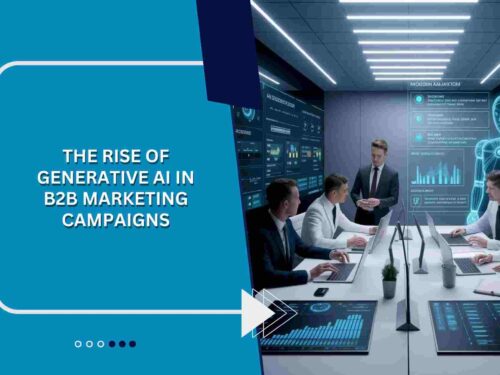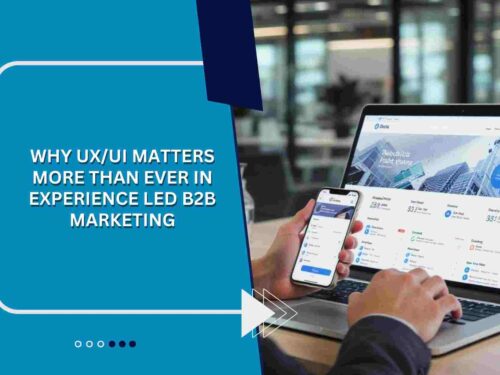In today’s hyper-connected digital landscape, lead generation has evolved beyond static web forms and cold outreach. Businesses are constantly seeking smarter, faster, and more personalized ways to engage prospects. This is where Conversational AI and chatbots have emerged as game-changers, transforming traditional lead generation into an interactive and intelligent experience. By automating real-time conversations, qualifying leads instantly, and delivering personalized interactions, these technologies are redefining how businesses attract and convert potential customers.
As buyer journeys grow more complex and real-time expectations increase, conversational AI offers a scalable and intelligent solution to keep up with changing B2B dynamics. At Acceligize, we recognize the immense potential of conversational AI in enhancing lead generation and helping businesses stay competitive.
The Rise of Conversational AI in Lead Generation
Conversational AI refers to technologies that enable machines to understand, process, and respond to human language. These systems are powered by natural language processing (NLP), machine learning, and contextual awareness. Unlike rule-based bots, conversational AI agents can engage in more dynamic and meaningful interactions.
In the realm of lead generation, this translates into automated, intelligent conversations that gather user data, qualify prospects, and route them appropriately all in real-time. Whether it’s a chatbot on your website, a virtual assistant on WhatsApp, or an AI-powered voice bot on the phone, these tools allow brands to connect with leads instantly, 24/7.
Why Traditional Lead Generation Needs a Revamp
The traditional approach to lead generation often involved static forms, long wait times, and manual data sorting. These methods are not only time-consuming but also lead to lost opportunities. According to research, over 55% of users abandon forms due to their length or complexity. Moreover, delayed follow-ups can result in cold leads and missed conversions.
Modern consumers expect instant engagement. With attention spans shrinking and competition rising, conversational AI allows businesses to proactively interact with visitors, answer questions, and nurture interest right from the first touchpoint.
How Chatbots Drive Lead Generation
AI-powered chatbots are at the heart of conversational AI strategies. These digital agents are capable of:
1. Capturing Lead Information in Real-Time
When a visitor lands on your website, a chatbot can instantly greet them, understand their intent, and collect vital lead data such as name, email, company, and pain points. This interaction feels natural and non-intrusive, increasing the likelihood of user engagement.
2. Qualifying Leads with Smart Logic
Chatbots can use predefined workflows and AI models to segment and qualify leads based on responses. For example, if a visitor indicates they’re a decision-maker from an enterprise-level company, the chatbot can flag the lead as high priority for immediate follow-up.
3. Booking Appointments and Demos
Instead of asking leads to fill out forms or wait for a call, chatbots can directly schedule meetings or product demos. Integrations with tools like Calendly, Zoom, or HubSpot make this process seamless, shortening the sales cycle significantly.
4. Providing Instant Responses to FAQs
Quick answers build trust. By resolving common queries instantly, chatbots prevent drop-offs and keep users engaged. When users feel informed, they are more likely to progress through the funnel.
5. Enabling Multi-Channel Conversations
Modern chatbots work across multiple platforms websites, mobile apps, Facebook Messenger, WhatsApp, Slack, and more. This allows brands to capture leads from wherever their audience prefers to engage.
Conversational AI Use Cases in Lead Generation
The applications of conversational AI for lead generation are extensive across industries:
- B2B SaaS: Chatbots qualify inbound traffic, book demos, and hand off sales-ready leads.
- E-commerce: AI bots recommend products, recover abandoned carts, and gather customer preferences.
- Healthcare: Virtual assistants answer health queries and schedule consultations.
- Finance: Chatbots simplify quote generation, loan applications, and document collection.
- Education: Bots assist in course selection, admission queries, and collecting student leads.
Each of these use cases highlights how businesses can use conversational AI to increase efficiency, reduce manual workloads, and improve conversion rates.
Key Benefits of Conversational AI in Lead Generation
Adopting AI-powered chatbots and virtual assistants delivers tangible business value:
1. 24/7 Lead Engagement
Chatbots don’t sleep. They’re available round-the-clock, ensuring no lead goes unengaged regardless of time zone or working hours.
2. Scalability
Whether handling 10 or 10,000 users simultaneously, AI bots scale effortlessly—offering consistent, high-quality interactions to every prospect.
3. Personalized Experiences
With machine learning, chatbots can deliver tailored messages based on user behavior, location, device type, and past interactions.
4. Faster Lead Conversion
By instantly qualifying and routing leads to the right team members or tools, conversational AI significantly shortens the path to conversion.
5. Enhanced Data Accuracy
Real-time lead capture minimizes manual data entry errors and ensures that CRM systems are updated with clean, accurate data.
Building an Effective Conversational AI Strategy
To fully leverage conversational AI for lead generation, companies must build a strategy aligned with their goals. Here’s how to structure it:
Identify Your Target Audience
Start by defining who your ideal customer is. Understand their pain points, behavior, and decision-making process to design bot conversations that resonate.
Map the Customer Journey
Analyze where prospects typically drop off or disengage. Implement chatbots at these critical touchpoints to keep the journey moving forward.
Develop Human-Centric Dialogues
Avoid robotic scripts. Use conversational tone, empathy, and humor to make interactions engaging. AI must feel human, not forced.
Integrate with CRM and Sales Tools
Ensure your chatbot integrates with platforms like Salesforce, Zoho CRM, or Marketo. This ensures seamless lead handover and follow-up by sales teams.
Train Your AI Models
Use historical data to train your bots. Continuously improve their responses using NLP advancements and feedback loops.
Monitor and Optimize
Track metrics like lead capture rate, bot abandonment, response time, and conversion rates. Use this data to fine-tune bot workflows regularly.
Trends Shaping the Future of Conversational AI in Lead Generation
The evolution of AI technology continues to unlock new capabilities in lead generation. Key trends to watch include:
Voice-Activated Bots
Voice AI is gaining momentum. Smart speakers and voice search are creating new touchpoints for capturing and converting leads.
Hyper-Personalization
With access to more behavioral and contextual data, bots are becoming ultra-personalized in how they engage, recommend, and upsell.
Sentiment Analysis
AI can now gauge user emotions and adapt conversations accordingly leading to more empathetic and relevant interactions.
Advanced AI models predict which leads are most likely to convert, enabling sales teams to prioritize high-value prospects.
Conversational Ads
Platforms like Facebook and Google are offering ad formats where users can engage with bots directly from ads turning ad clicks into instant conversations.
Chatbots vs. Conversational AI: What’s the Difference?
While often used interchangeably, there’s a difference between rule-based chatbots and true conversational AI:
- Chatbots operate on scripts and pre-defined triggers. They follow a linear decision tree and can’t adapt to unexpected queries.
- Conversational AI is powered by NLP and ML. It understands user intent, learns from interactions, and delivers more fluid, contextual conversations.
For lead generation, conversational AI is significantly more powerful and flexible than traditional bots. It mimics human interaction more closely, which builds trust and boosts conversions.
Common Challenges and How to Overcome Them
Despite its advantages, implementing conversational AI isn’t without hurdles:
- Integration Complexity: Choose bots with plug-and-play integration with your existing tech stack.
- User Resistance: Clearly indicate that users are speaking with a bot and offer easy escalation to human support.
- Data Privacy: Ensure your AI solutions are compliant with GDPR, HIPAA, or other relevant data laws.
- Lack of Training: Continuously update AI models to ensure they remain relevant and accurate.
These challenges can be mitigated with proper planning, ongoing optimization, and choosing the right AI partner.
Why Conversational AI is the Future of Lead Generation
The way people engage with brands has fundamentally changed. They expect immediacy, relevance, and personalization. Conversational AI meets these demands at scale, turning passive website visits into active conversations and potential deals.
With AI becoming smarter every day, it’s clear that conversational interfaces are the future of lead generation. They offer businesses a chance to be proactive, predictive, and present at the exact moment a lead expresses interest.
If your business isn’t using conversational AI to drive leads, you’re leaving opportunity on the table.
Ready to supercharge your lead generation strategy with Conversational AI?
Let Acceligize help you implement intelligent chatbot solutions tailored to your business needs.




